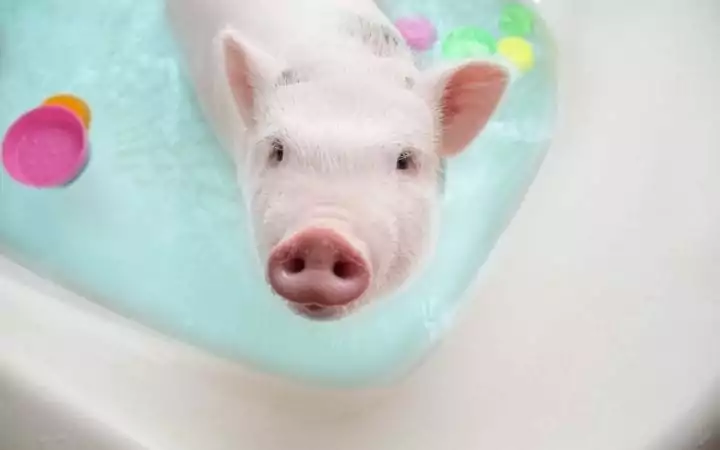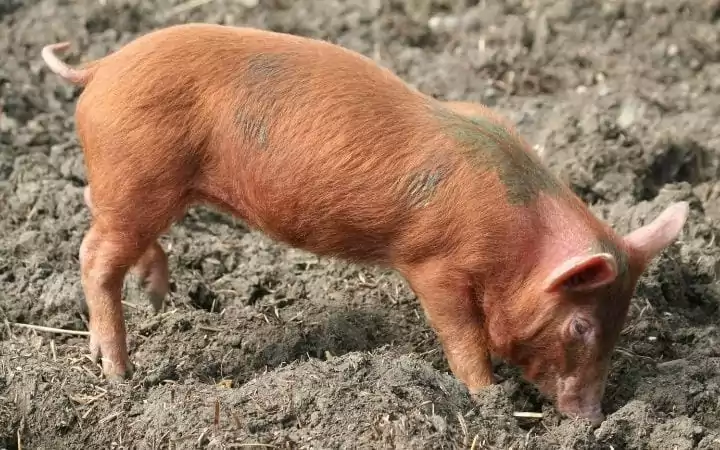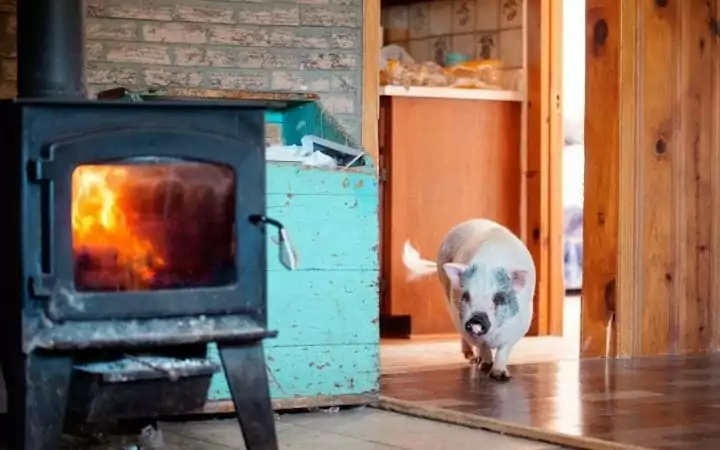Following on the heels of the first part of our comprehensive article, we will now continue with our discovery on all the things you need to know before getting a pet pig.
Bathing and Swimming
Some pigs like to have a bath, but others don’t. If you are planning on giving your piglet baths, it’s advisable to start as early as possible. But don’t too it too much either, as this might dry out your pig’s skin.
When you do bathe them ensure it is with natural oatmeal shampoo, specially developed for their skin types.
Pigs can also swim, and doggy paddles just like a pupper.
Mud
Pigs are mud and mud are pigs, right? Nopes! Well, not for all of them anyway. They have their own unique personalities, just like humans do. Some pigs like to roll in the mug and dig, and others don’t like it.
Mud is like sunscreen to pigs and protects their skin against the harmful UV rays of the sun.
Rooting
Pigs need minerals in the soil, and it is therefore completely natural for them to want to dig up your prized garden in search of these treasures. The situation can be mitigated by building an outside pen for your pig or allocating a section to them where they can dig and root as they please.
Another idea that you can try is to get a large plastic tub, fill it with play sand or plastic balls, and sprinkle it with dried fruits and nuts. This will keep them occupied for hours.
Grooming
Your pig will need to have their hooves trimmed, you can either do this yourself on a frequent basis or make use of a farrier or professional to have this done.
Regular trimming is required to ensure that there is no added pressure on their hooves and joints. Start getting your piglet used to the idea, by playing with their feet and hooves when they are still young.
It is no secret that pigs like to be brushed. Some pigs will scratch themselves, holding quite a rhythm to scratch that itch against furniture, the ground, trees, or walls…basically anything – even against you.
When your pig shows symptoms of dry skin, you can apply an Aqueous baby cream or coconut oil on a regular basis. Adding a teaspoon a day of coconut oil can also assist in combatting this common issue.
Ensure that your pig is treated every day with a high factor sunscreen to avoid sunburn and blistering.
Dippity Pig Syndrome
It might not sound scary, but trust us, it is indeed traumatizing for both the pig and its parent. Pigs are sensitive and emotional creatures and any changes in their routine, diet, or environment (sunburn) can affect them in a negative way.
You might go to bed and your piglet is feeling and looking fine, just for it to wake up the next morning, screaming in pain, with lesions on their back, and looking like they are paralyzed in the back.
This is a very common occurrence and not a major cause for concern. It is otherwise known as “bleeding back syndrome”. The lesions literally resemble a child that has been beaten with a leather strap and even forms scabs after a few days. Magically, there is no scarring afterward. It is indeed purely psychological!
Turning Tricks
Pigs are amongst the smartest creatures on the planet, and believe it or not, they love training! Use Cheerios or an appropriate home-made snack to train them. You will need a lot of patience, but you will be super surprised at how fast they learn tricks. Check out this video:
Treats in moderation
Pigs will be asking you for food and treats at every opportunity they can get! Especially very focally plead their case to your visitors by making them believe that they are not adequately fed.
Like any other animal, treats should be kept in moderation. No sweets, chips, etc should be given in excess amounts.
Potty Training
Piglets will need to be housetrained if they are to stay inside the house. However, it is important to know that this process can take up to 6 months. Your piglet should not have full roam of the house until they have been broken in.
Use a partition and section them off to a certain area for a few weeks. Add a pee pad and diapers into the pen. Then at a gradual pace, increase the amount of space they have, moving the pee pad closer to the door, and encouraging your baby with treats to go potty outside.
After a while, they will get the hang of it, and will even stand at the door or vocalize their need to you to go outside. It is especially helpful if you have other pets like dogs that also go potty outside, as they tend to follow them around.
Do’s and Don’ts – The last word
A few last words of advice:
- Get your pig neutered or spayed. This will help with aggression and issues of moodiness.
- Do not overfeed your pig.
- Book a veterinary appointment at an exotic practice for your pig as soon as possible to discuss vaccinations, deworming, diet, and any other questions you might have.
Share your stories and pictures with us, we would love your feedback!



